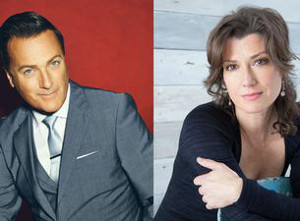Based on the results thus far, the search for the Winston-Salem Symphony’s new music director will not be clear-cut or easy. The second candidate, Alfred Savia, currently Music Director of the Evansville (Indiana) Philharmonic Orchestra, led the October 17 concert in the Stevens Center. He has held assistant, associate and resident conductorships with an impressive array of orchestras such as the Florida Symphony, the Indianapolis Symphony, and the New Orleans Symphony, and he has an active guest-conducting schedule in the US and abroad. His instrument is the clarinet, and he has worked with two Piedmont NC composers, Greensboro’s Russell Peck and the NCSA’s Lawrence Dillon.
Musical fireworks in the form of the 21-year-old Samuel Barber’s exuberant Overture to The School for Scandal opened the program. Every section of the orchestra was alert, and the ensemble was tight – as it was throughout the concert. The many woodwind parts were beautifully handled, and the horns, led by Robert Campbell, were brilliant. Principal Oboist John Ellis phrased the important second melody with admirable sensitivity. The only thing missing from Savia’s interpretation was an undercurrent of wistful melancholy beneath the ebullience which should be rather like a lonely commedia dell’arte harlequin in a Jean-Antoine Watteau painting. This mood haunts Barber’s works like autumnal regret in late Brahms, and Barber’s best interpreters, such as the late Thomas Shippers and Andrew Schenck, bring this out.
Dvorák’s Cello Concerto in B Minor, Op. 104, recently performed by Brooks Whitehouse at UNCG, proved to be an ideal vehicle to test the mettle of Savia and to display the virtuosity of cellist Marcy Rosen, familiar as a founding member of the Mendelssohn String Quartet. The orchestral introduction, unusually well prepared, featured an outstanding horn solo played by Campbell. Using a 1720 David Techler cello, Rosen produced rich and well-balanced tone and phrased with great sensitivity. Her intonation was well controlled and focused while her bowing made light of the work’s difficulties. Rosen’s playful dialogue with various woodwinds was delightful. Her duet with Concertmistress Corine Brouwer in the last movement featured ideally matched ensemble. The horn trio in the second movement established a new regional benchmark to which others may aspire. With careful attention to balances, Savia created an orchestral garb that matched Rosen’s every thrust and parry.
The rhythmic four-note motif that dominates Beethoven’s Symphony No. 5 in C Minor, Op. 67, is so familiar that we think we have heard the work a lot more than we actually have. A routine performance would be the kiss of death for any candidate for music director, but Savia conducted the piece without a score, and it burned with a fierce intensity from the galvanizing opening to the sustained triumph of the last movement. Every section of the orchestra was in top form, and the string sections played as one, giving the feel of chamber music. The horns’ fortissimo statement of the second theme of the first movement was glorious, and Ellis’s little oboe cadenza was a gem. The high quality of the string sections was further evident in such things as the wonderful melody sung by the violas and cellos in unison over pizzicato double basses at the opening of the second movement. With Savia taking a faster-than-average approach to the work, the third movement, full of bold contracts, was even more vivacious than usual. The link between the last two movements was played with exemplary choices of dynamics and phrasing, and Principal Timpanist Massie Johnson subtly built up the crescendo over quiet strings that leads the full orchestra’s blazing, march-like theme. The relentless momentum was never allowed to slacken, and the symphony ended with everyone swept up in a tidal wave of triumph.
Rosen and Savia appeared onstage in a brief “Meet the Artists” session after the concert. Both praised the high level of musicianship Conductor Emeritus Peter Perret built up in the orchestra, with Savia stressing it in absolute terms, not just “for a city of Winston-Salem’s size.” Rosen noted that her Techler cello is unusually large and had never been reduced to a more “standard” size. Savia said that, if selected, he would maintain active use of the orchestra’s chorus and of the NCSA’s choral resources. His innovations might include using visual elements to entice the MTV generation. He has used dancers and actors on occasion, such as a “Romeo and Juliet” evening with selections from Berlioz, Tchaikovsky, and Prokofiev.











